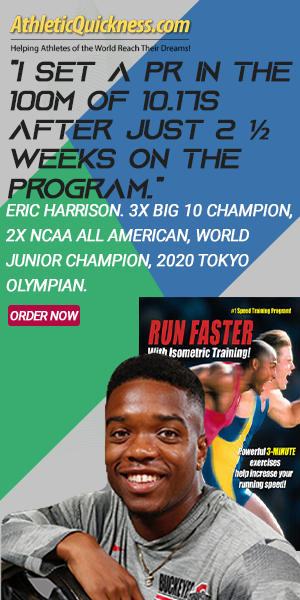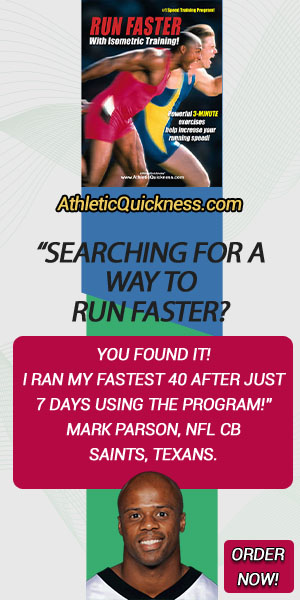The following article was produced in response to this person’s inquiry: Good evening. I have read this paper and I am interested in learning if you have done any work with the throwing motion of a football using isometrics and resistance bands. Thank you so much and I look forward to hearing from you! I do have a training football which has a small loop on one end that could be attached to a band.
Thanks for the inquiry. Throwing motions, such as those for a football or baseball, as well as swinging motions, such as those for a baseball bat, golf club or tennis racket all have similarities with respect to the muscles used to produce these skills as well as the order they are used.
Generally speaking, all of these (throwing and swinging) activities begin with rotating away from the intended target, first, before changing directions back toward it. This ‘backward, first, then forward’ movement of the body produces what is known as myotatic reflexes.
A myotatic reflex is a stretch reflex that one can create within their muscles. It is needed for faster, more powerful throws or swings. It is also needed for other activities, too, in people as well as pets. You may be familiar with watching a cat jump up on table. You’ll notice they go backward, first to stretch/load their muscles, i.e., activate their myotatic reflexes, before jumping upward/forward. People do it all the time as well, such as before getting out of a soft chair from a seated position.
This myotatic reflex, however, is only available within a muscle for a short time before it dampens out, or, disappears altogether such as less than 0.5 seconds. So, naturally, the motion within all of the necessary muscles to produce a desired activity has to occur rather suddenly otherwise, the benefit of the reflexes within them, is lost.
With that, let’s use throwing a football as our example. Once the decision is made to throw the ball toward the receiver, or, target the entire activity must take place very quickly to make use of these reflexes. So, how are they created? First, the ball must travel backward with respect to person who is throwing it.
This begins with the hand (holding the ball) going backward, followed by the backward movement/rotation of the shoulder, then the backward movement/rotation of the spine and finally the backward movement/rotation of the hips. All of these regions of the body must first go/rotate in the opposite direction of the intended target, to stretch their associated muscles and therefore, to create their own myotatic reflexes.
Once the last region of the body has rotated away, that being the hips, they now become the first to rotate back toward the intended target. Again, this has to happen very fast, such as less than 0.5 seconds. This is then followed in reverse order with the spine rotating back toward the intended target, followed by the shoulder rotating back toward the intended target and finally the arm/hand holding the ball moving back toward the intended target.
Interestingly, if you were to slow down someone’s throwing motion of a football on video, you will notice that once the hips have reversed their direction and made their change, back toward the intended target, the hand holding the ball, as well as the shoulder and spine, are all observed to still be going backward, away from it.
This is all by design and is necessary because it helps to create as much stretch across the entire body as possible because the more a muscle stretches before being used, the stronger the myotatic reflex within it is created. And a stronger myotatic reflex will allow anyone to perform their skill faster and with more power.
This (hips rotate back toward the target, first, while everything else is still going away from it) essentially turns the body into a whip. You may also be familiar with a similar activity such as casting a fishing rod. The hand holding the rod goes backward, first, then suddenly forward. As the hand goes forward to cast the line into the water, the tip of the rod is still going backward, away from the water. This helps to bend the rod, creating its own ‘stretch reflex’ within it for a quicker and stronger cast, or, whip.
So, that’s basically what happens when someone is throwing or swinging an object. A stretch reflex needs to be produced in all of the muscles used in the motion and acted upon within a very short period of time.
Now I suppose you’d like to know how this information can help you. It’s been our experience that when it comes to all of these throwing and swinging activities, athletes are really good at exercising the muscles that are obvious to them and those are typically with the arms, shoulders and back. Rarely, however, do we encounter an athlete who has ever given any attention to their hips, at least as far as rotation is concerned.
Rotation of the hips is one of the many hidden keys to being a better athlete. One reason it’s hidden is because there are no exercise machines in existence to draw one’s attention to it and so athletes never know to train their hip rotator muscles in the first place. There could be other reasons, as well, as to why these muscles go untrained.
Strong hip rotator muscles are the foundation for all of your throwing and swinging motions. This should at least be a little more apparent based on how we described they are used. However, if these muscles are weak, the change of direction phase will be slow and therefore you will not be able to produce a good enough myotatic reflex within them resulting in slower and short throws.
All of our training programs have exercises that target the hip rotator muscles, not surprisingly. The simplest and most effective one at this time for throwing a football, I believe, would be our Run Faster program simply because more emphasis is placed on these muscles than any others.
At the risk of making this program too complicated for the younger athlete, it does not explicitly identify these muscles as being trained with certain exercises since it would likely take away from the ease in which the program was meant to be implemented.
However, and for your information, whenever the program specifically targets the hip flexor muscles in one leg with the resistance band, the other leg’s internal hip rotators are being trained even though they are not named nor are they being exercised with the band. This has to do with the way this exercise is set up that requires the internal hip rotators being needed to counter the rotation in the body this hip flexor exercise inherently produces.
Also, whenever the program specifically targets the hip extensor muscles in one leg, the other leg’s external hip rotators are being trained though they are not named nor are they being exercised with that band. Similarly, this has to do with the way this exercise is set up that requires the external hip rotators being needed to counter the rotation in the body this hip extensor exercise inherently produces.
As you can see, this can be quite a lengthy topic and I’ll leave it right there, for now. With respect to our programs, they are very easy to understand and implement. If you have any other questions, please feel free to contact us.





